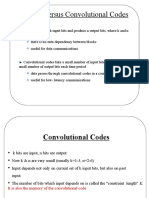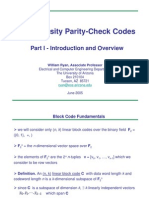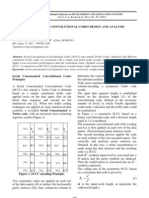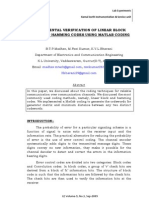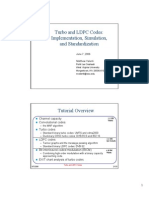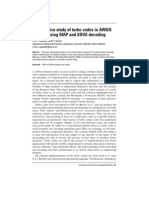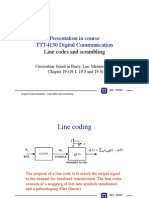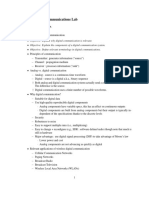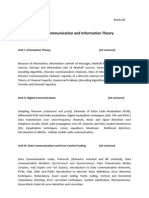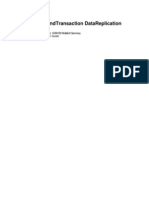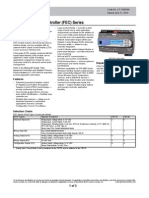Convolutional Codes Turbo Codes LDPC Codes
Convolutional Codes Turbo Codes LDPC Codes
Uploaded by
veerutheprinceCopyright:
Available Formats
Convolutional Codes Turbo Codes LDPC Codes
Convolutional Codes Turbo Codes LDPC Codes
Uploaded by
veerutheprinceOriginal Description:
Original Title
Copyright
Available Formats
Share this document
Did you find this document useful?
Is this content inappropriate?
Copyright:
Available Formats
Convolutional Codes Turbo Codes LDPC Codes
Convolutional Codes Turbo Codes LDPC Codes
Uploaded by
veerutheprinceCopyright:
Available Formats
Convolutional codes
Turbo codes
LDPC codes
Turbo and LDPC Codes:
Binary Convolutional Codes
A convolutional encoder comprises:
k input streams
We assume k=1 throughout this tutorial.
n output streams
m delay elements arranged in a shift register.
Combinatorial logic (OR gates).
Each of the n outputs depends on some modulo-2 combination of the k current
inputs and the m previous inputs in storage
The constraint length is the maximum number of past and present
input bits that each output bit can depend on.
K = m + 1
Constraint Length K = 3
D D
Recursive Systematic
Convolutional (RSC) Codes
An RSC encoder is constructed from a standard convolutional encoder
by feeding back one of the outputs.
An RSC code is systematic.
The input bits appear directly in the output.
D D
i
x
i
r
D D
Parallel Concatenated Codes
with Nonuniform Interleaving
A stronger code can be created by encoding in parallel.
A nonuniform interleaver scrambles the ordering of bits at the input
of the second encoder.
Uses a pseudo-random interleaving pattern.
It is very unlikely that both encoders produce low weight code words.
MUX increases code rate from 1/3 to 1/2.
Higher code rates Rc are obtained by transmitting
only some of the parity bits (puncturing)
RSC
#1
RSC
#2
Nonuniform
Interleaver
MUX
Input
Parity
Output
Systematic Output
i
x
Random Coding Interpretation
of Turbo Codes
Random codes achieve the best performance.
Shannon showed that as n, random codes achieve channel
capacity.
However, random codes are not feasible.
The code must contain enough structure so that decoding can be
realized with actual hardware.
Coding dilemma:
All codes are good, except those that we can think of.
With turbo codes:
The nonuniform interleaver adds apparent randomness to the
code.
Yet, they contain enough structure so that decoding is feasible.
Characteristics of Turbo Codes
Turbo codes have extraordinary performance at low SNR.
Very close to the Shannon limit.
Due to a low multiplicity of low weight code words.
However, turbo codes have high BER .
This is due to their low minimum distance.
Performance improves for larger block sizes.
Larger block sizes mean more latency (delay).
However, larger block sizes are not more complex to decode.
The BER is lower for larger frame/ interleaver sizes
The complexity of a constraint length K
TC
turbo code is the
same as a K = K
CC
convolutional code, where:
K
CC
~ 2+K
TC
+ log
2
(number decoder iterations)
Turbo Encoder
Data is segmented into blocks of L bits.
where 40 s L s 5114
Upper
RSC
Encoder
Lower
RSC
Encoder
Interleaver
Systematic
Output
X
k
Uninterleaved
Parity
Z
k
Interleaved
Parity
Z
k
Input
X
k
Interleaved
Input
X
k
Output
Interleaver:
Inserting Data into Matrix
Data is fed row-wise into a R by C matrix.
R = 5, 10, or 20.
8 s C s 256
If L < RC then matrix is padded with dummy characters.
X
1
X
2
X
3
X
4
X
5
X
6
X
7
X
8
X
9
X
10
X
11
X
12
X
13
X
14
X
15
X
16
X
17
X
18
X
19
X
20
X
21
X
22
X
23
X
24
X
25
X
26
X
27
X
28
X
29
X
30
X
31
X
32
X
33
X
34
X
35
X
36
X
37
X
38
X
39
X
40
Interleaver:
Intra-Row Permutations
Data is permuted within each row.
Permutation rules are rather complicated.
See spec for details.
X
2
X
6
X
5
X
7
X
3
X
4
X
1
X
8
X
10
X
12
X
11
X
15
X
13
X
14
X
9
X
16
X
18
X
22
X
21
X
23
X
19
X
20
X
17
X
24
X
26
X
28
X
27
X
31
X
29
X
30
X
25
X
32
X
40
X
36
X
35
X
39
X
37
X
38
X
33
X
34
Interleaver:
Inter-Row Permutations
Rows are permuted.
If R = 5 or 10, the matrix is reflected about the middle row.
For R=20 the rule is more complicated and depends on L.
See spec for R=20 case.
X
40
X
36
X
35
X
39
X
37
X
38
X
33
X
34
X
26
X
28
X
27
X
31
X
29
X
30
X
25
X
32
X
18
X
22
X
21
X
23
X
19
X
20
X
17
X
24
X
10
X
12
X
11
X
15
X
13
X
14
X
9
X
16
X
2
X
6
X
5
X
7
X
3
X
4
X
1
X
8
Interleaver:
Reading Data From Matrix
Data is read from matrix column-wise.
Thus:
X
1
= X
40
X
2
= X
26
X
3
= X
18
X
38
= X
24
X
2
= X
16
X
40
= X
8
X
40
X
36
X
35
X
39
X
37
X
38
X
33
X
34
X
26
X
28
X
27
X
31
X
29
X
30
X
25
X
32
X
18
X
22
X
21
X
23
X
19
X
20
X
17
X
24
X
10
X
12
X
11
X
15
X
13
X
14
X
9
X
16
X
2
X
6
X
5
X
7
X
3
X
4
X
1
X
8
UMTS Constituent RSC Encoder
Upper and lower encoders are identical:
Feedforward generator is 15 in octal.
Feedback generator is 13 in octal.
D D D
Parity Output
(Both Encoders)
Systematic Output
(Upper Encoder Only)
Encoding Termination
After the L
th
input bit, a 3 bit tail is calculated.
The tail bit equals the fed back bit.
This guarantees that the registers get filled with zeros.
Each encoder has its own tail.
The tail bits and their parity bits are transmitted at the end.
D D D
X
L+1
X
L+2
X
L+3
Z
L+1
Z
L+2
Z
L+3
Output Stream Format
The format of the output steam is:
X
1
Z
1
Z
1
X
2
Z
2
Z
2
X
L
Z
L
Z
L
X
L+1
Z
L+1
X
L+2
Z
L+2
X
L+3
Z
L+3
X
L+1
Z
L+1
X
L+2
Z
L+2
X
L+3
Z
L+3
L data bits and
their associated
2L parity bits
(total of 3L bits)
3 tail bits for
upper encoder
and their
3 parity bits
3 tail bits for
lower encoder
and their
3 parity bits
Total number of coded bits = 3L + 12
Code rate: r
L
L
=
+
~
3 12
1
3
Turbo Decoding Architecture
Upper
MAP
Decoder
r(X
k
)
r(Z
k
)
Lower
MAP
Decoder
r(Z
k
)
Initialization and timing:
Upper decoder executes first, then lower decoder.
X
k
Interleave
Deinnterleave
Demux
zeros
Demux
Preface to LDPC Codes:
Review of Linear Block Codes
V
n
= n-dimensional vector space over {0,1}
A (n, k) linear block code with dataword length k, codeword length n
is a k-dimensional vector subspace of V
n
A codeword c is generated by the matrix multiplication c = uG, where
u is the k-bit long message and G is a k by n generator matrix
The parity check matrix H is a n-k by n matrix of ones and zeros,
such that if c is a valid codeword then, cH
T
= 0
Each row of H specifies a parity check equation. The code bits in
positions where the row is one must sum (modulo-2) to zero
Low-Density Parity-Check Codes
Low-Density Parity-Check (LDPC) codes are a class of linear block
codes characterized by sparse parity check matrices H
H has a low-density of 1s
LDPC codes were originally invented by Robert Gallager in the early
1960s but were largely ignored until they were rediscovered in the
mid-1990s by MacKay
Sparseness of H can yield large minimum distance d
min
and reduces
decoding complexity
Can perform within 0.0045 dB of Shannon limit
Decoding LDPC codes
Like Turbo codes, LDPC can be decoded iteratively
Instead of a trellis, the decoding takes place on a Tanner graph
Messages are exchanged between the v-nodes and c-nodes
Edges of the graph act as information pathways
Hard decision decoding
Bit-flipping algorithm
Soft decision decoding
Sum-product algorithm
Also known as message passing/ belief propagation algorithm
Min-sum algorithm
Reduced complexity approximation to the sum-product algorithm
In general, the per-iteration complexity of LDPC codes is less than it is
for turbo codes
However, many more iterations may be required (max~100;avg~30)
Thus, overall complexity can be higher than turbo
Tanner Graphs
A Tanner graph is a bipartite graph that describes the parity check
matrix H
There are two classes of nodes:
Variable-nodes: Correspond to bits of the codeword or equivalently, to
columns of the parity check matrix
There are n v-nodes
Check-nodes: Correspond to parity check equations or equivalently, to
rows of the parity check matrix
There are m=n-k c-nodes
Bipartite means that nodes of the same type cannot be connected (e.g. a
c-node cannot be connected to another c-node)
The i
th
check node is connected to the j
th
variable node iff the (i,j)
th
element of the parity check matrix is one, i.e. if h
ij
=1
All of the v-nodes connected to a particular c-node must sum (modulo-2)
to zero
More on Tanner Graphs
A cycle of length l in a Tanner graph is a path of l distinct edges
which closes on itself
The girth of a Tanner graph is the minimum cycle length of the
graph.
The shortest possible cycle in a Tanner graph has length 4
f
0
f
1
f
2
v
0
v
1
v
2
v
3
v
4
v
5
v
6
v-nodes
c-nodes
Example: Tanner Graph
for (7,4) Hamming Code
(
(
(
=
1 0 0 1 1 0 1
0 1 0 1 0 1 1
0 0 1 0 1 1 1
H
f
0
f
1
f
2
v
0
v
1
v
2
v
3
v
4
v
5
v
6
v-nodes
c-nodes
Regular vs. Irregular LDPC codes
An LDPC code is regular if the rows and columns of H have
uniform weight, i.e. all rows have the same number of ones
(d
v
) and all columns have the same number of ones (d
c
)
The codes of Gallager were regular (or as close as possible)
Although regular codes had impressive performance, they are
still about 1 dB from capacity and generally perform worse than
turbo codes
An LDPC code is irregular if the rows and columns have
non-uniform weight
Irregular LDPC codes tend to outperform turbo codes for block
lengths of about n>10
5
Constructing Regular LDPC Codes:
MacKay, 1996
The idea is to randomly generate a M N matrix H with weight d
v
columns and weight d
c
rows, subject to some constraints
Construction 1: Overlap between any 2 columns is not greater than 1
Construction 2: M/2 columns have d
v
=2, with no overlap between any
pair of columns. Remaining columns have d
v
=3. As with 1A, the
overlap between any two columns is no greater than 1
Constructing Irregular LDPC Codes:
Luby, et. al., 1998
Luby et. al. developed LDPC codes based on irregular LDPC Tanner
graphs
Message and check nodes have conflicting requirements
Message nodes benefit from having a large degree
LDPC codes perform better with check nodes having low degrees
Irregular LDPC codes help balance these competing requirements
High degree message nodes converge to the correct value quickly
This increases the quality of information passed to the check nodes,
which in turn helps the lower degree message nodes to converge
Check node degree kept as uniform as possible and variable node
degree is non-uniform
Example of low-density Parity check code matrix H for
n=20,j=4,k=3
Encoding LDPC Codes
A linear block code is encoded by performing the matrix multiplication c = uG
A common method for finding G from H is to first make the code systematic
by adding rows and exchanging columns to get the H matrix in the form H =
[P
T
I]
Then G = [I P]
However, the result of the row reduction is a non-sparse P matrix
The multiplication c =[u uP] is therefore very complex
As an example, for a (10000, 5000) code, P is 5000 by 5000
Assuming the density of 1s in P is 0.5, then 0.5 (5000)
2
additions are required per
codeword
This is especially problematic since we are interested in large n (>10
5
)
An often used approach is to use the all-zero codeword in simulations
Encoding LDPC Codes
Richardson and Urbanke show that even for large n, the encoding
complexity can be (almost) linear function of n
Efficient encoding of low-density parity-check codes, IEEE Trans. Inf.
Theory, Feb., 2001
Using only row and column permutations, H is converted to an
approximately lower triangular matrix
Since only permutations are used, H is still sparse
The resulting encoding complexity in almost linear as a function of n
An alternative involving a sparse-matrix multiply followed by
differential encoding has been proposed by Ryan, Yang, & Li.
Lowering the error-rate floors of moderate-length high-rate irregular
LDPC codes, ISIT, 2003
Encoding LDPC Codes
Let H = [H
1
H
2
] where H
1
is sparse and
Then a systematic code can be generated with G = [I H
1
T
H
2
-T
].
It turns out that H
2
-T
is the generator matrix for an accumulate-code
(differential encoder), and thus the encoder structure is simply:
u u
uH
1
T
H
2
-T
Similar to Jin & McElieces Irregular Repeat Accumulate (IRA) codes.
Thus termed Extended IRA Codes
(
(
(
(
(
(
(
(
=
(
(
(
(
(
(
(
(
=
1
1 ...
1 ... 1
1 ... 1 1
1 ... 1 1 1
and
1 1
1 ... 1
1 1
1 1
1
2 2
T
H H
Multiply
by H
1
T
D
For example, the (7,4) Hamming code is
defined by the following parity check
equations
Decoding: Bit-Flipping Algorithm:
Example.1:(7,4) Hamming Code
f
1
=1
y
0
=1 y
1
=1 y
2
=1
y
3
=1
y
4
=0
y
5
=0
y
6
=1
c
0
=1 c
1
=0 c
2
=1
c
3
=1
c
4
=0
c
5
=0
c
6
=1
f
2
=0
Transmitted code word
Received code word
f
0
=1
Bit-Flipping Algorithm:
(7,4) Hamming Code
y
0
=1
y
2
=1
y
3
=1
y
6
=1
y
4
=0
y
5
=0
y
1
=1
f
2
=0
f
0
=1
f
1
=1
Bit-Flipping Algorithm:
(7,4) Hamming Code
y
0
=1
y
2
=1
y
3
=1
y
6
=1
y
4
=0
y
5
=0
y
1
=0
f
2
=0
f
0
=0
f
1
=0
Decoding
Generalized Bit-Flipping Algorithm
Step 1: Compute parity-checks
If all checks are zero, stop decoding
Step 2: Flip any digit contained in T or more failed check equations
Step 3: Repeat 1 to 2 until all the parity checks are zero or a maximum
number of iterations are reached
The parameter T can be varied for a faster convergence
Example 2: Double error
1 0 0 0 0 0 0 0 0 0 0 0 0 0 0 1
Iteration #1
Example 2: Double error
1 0 0 0 0 0 0 0 0 0 0 0 0 0 0 1
Iteration #1
Example 2: Double error
1 0 0 0 0 0 0 0 0 0 0 0 0 0 0 1
Iteration #1
2 0 1 1 0 1 1 1 0 2 1 1 0 1 1 2
Example 2: Double error
Iteration #1
2 0 1 1 0 1 1 1 0 2 1 1 0 1 1 2
0 0 0 0 0 0 0 0 0 1 0 0 0 0 0 0
Example 2: Double error
Iteration #2
0 0 0 0 0 0 0 0 0 1 0 0 0 0 0 0
Example 2: Double error
Iteration #2
0 0 0 0 0 0 0 0 0 1 0 0 0 0 0 0
Example 2: Double error
Iteration #2
0 0 0 0 0 0 0 0 0 1 0 0 0 0 0 0
Example 2: Double error
Iteration #2
0 0 0 0 0 0 0 0 0 1 0 0 0 0 0 0
Example 2: Double error
Iteration #2
0 0 0 0 0 0 0 0 0 1 0 0 0 0 0 0
1 0 0 0 0 1 1 0 0 2 0 1 0 1 0 1
Example 2: Double error
Iteration #2
0 0 0 0 0 0 0 0 0 0 0 0 0 0 0 0
1 0 0 0 0 1 1 0 0 2 0 1 0 1 0 1
Example 2: Double error
Iteration #2
0 0 0 0 0 0 0 0 0 0 0 0 0 0 0 0
Done
Generalized Bit Flipping:
(15,7) BCH Code
f
0
=1 f
1
=0 f
2
=0
f
3
=0 f
4
=1 f
5
=0 f
6
=0 f
7
=1
Transmitted code word
c
0
=0 c
1
=0
c
2
=0
c
3
=0
c
4
=0
c
5
=0
c
6
=0
c
7
=0 c
8
=0 c
9
=0 c
10
=0 c
11
=0 c
12
=0 c
13
=0 c
14
=0
y
0
=0 y
1
=0
y
2
=0
y
3
=0
y
4
=1
y
5
=0
y
6
=0
y
7
=0 y
8
=0 y
9
=0 y
10
=0 y
11
=0 y
12
=0 y
13
=0 y
14
=1
Received code word
Generalized Bit Flipping:
(15,7) BCH Code
f
0
=0 f
1
=0 f
2
=0
f
3
=0 f
4
=0 f
5
=0 f
6
=0 f
7
=1
y
0
=0 y
1
=0
y
2
=0
y
3
=0
y
4
=0
y
5
=0
y
6
=0
y
7
=0 y
8
=0 y
9
=0 y
10
=0 y
11
=0 y
12
=0 y
13
=0 y
14
=1
Generalized Bit Flipping:
(15,7) BCH Code
f
0
=0 f
1
=0 f
2
=0
f
3
=0 f
4
=0 f
5
=0 f
6
=0 f
7
=0
y
0
=0 y
1
=0
y
2
=0
y
3
=0
y
4
=0
y
5
=0
y
6
=0
y
7
=0 y
8
=0 y
9
=0 y
10
=0 y
11
=0 y
12
=0 y
13
=0 y
14
=0
Halting Criteria
After each iteration, halt if:
This is effective, because the probability of an undetectable decoding
error is negligible
Otherwise, halt once the maximum number of iterations is reached
If the Tanner graph contains no cycles, then Q
i
converges to the true
APP value as the number of iterations tends to infinity
0 H c =
T
Applications
In 2003, an LDPC code beat six different turbo codes to become the
error correcting code in the new DVB-S2 standard for the satellite
transmission of digital television. The latest version of the standard
DVB-S2 uses a concatenation of an outer BCH code and inner LDPC
code
In 2008, LDPC beat convolutional turbo codes as the FEC scheme for
the ITU-T G.hn standard.
G.hn chose LDPC over turbo codes because of its lower decoding
complexity (especially when operating at data rates close to 1 Gbit/s)
and because the proposed turbo codes exhibited a significant error
rate at the desired range of operation.
LDPC is also used for 10GBase-T Ethernet, which sends data at 10
gigabits per second over twisted-pair cables. As of 2009, LDPC codes
are also part of the Wi-Fi 802.11 standard as an optional part
of 802.11n, in the High Throughput (HT) PHY specification
You might also like
- Mobile and Wireless Communication Complete Lecture Notes #1Document22 pagesMobile and Wireless Communication Complete Lecture Notes #1Student Lecture Notes100% (3)
- Low Density Parity Check Codes1Document41 pagesLow Density Parity Check Codes1Prithvi RajNo ratings yet
- Low Density Parity Check CodesDocument21 pagesLow Density Parity Check CodesPrithvi Raj0% (1)
- Asst. Prof. Anindita Paul: Mintu Kumar Dutta Sudip Giri Saptarshi Ghosh Tanaka Sengupta Srijeeta Roy Utsabdeep RayDocument38 pagesAsst. Prof. Anindita Paul: Mintu Kumar Dutta Sudip Giri Saptarshi Ghosh Tanaka Sengupta Srijeeta Roy Utsabdeep RayUtsav Determined RayNo ratings yet
- Convolutional CodeDocument15 pagesConvolutional CodeDhivya LakshmiNo ratings yet
- Tornado Codes and Luby Transform Codes PDFDocument12 pagesTornado Codes and Luby Transform Codes PDFpathmakerpkNo ratings yet
- Turbo CodesDocument28 pagesTurbo CodesSharad KaushikNo ratings yet
- Turbo Codes 1. Concatenated Coding System: RS Encoder Algebraic Decoder Layer 2Document27 pagesTurbo Codes 1. Concatenated Coding System: RS Encoder Algebraic Decoder Layer 2Shathis KumarNo ratings yet
- LDPC OptimizationDocument32 pagesLDPC OptimizationShajeer KaniyapuramNo ratings yet
- Lec8 ConvDocument28 pagesLec8 ConvYaseen MoNo ratings yet
- Turbo CodesDocument28 pagesTurbo CodesPrasant Kumar Barik100% (1)
- Efficient Maximum Likelihood Decoding of Linear Block Codes Using A TrellisDocument5 pagesEfficient Maximum Likelihood Decoding of Linear Block Codes Using A Trellisvidisha nitinNo ratings yet
- Performance Comparison of LDPC Codes and Turbo CodesDocument8 pagesPerformance Comparison of LDPC Codes and Turbo CodesSinshaw BekeleNo ratings yet
- Convolutional CodesDocument7 pagesConvolutional CodesgayathridevikgNo ratings yet
- Information Theory & Coding: UnderstandDocument126 pagesInformation Theory & Coding: UnderstandSaraswathi AsirvathamNo ratings yet
- CS1 - 40711502818 - Jatin GargDocument4 pagesCS1 - 40711502818 - Jatin GargVedant KaushishNo ratings yet
- III LDPC Code Tutorial1Document106 pagesIII LDPC Code Tutorial1Maria AslamNo ratings yet
- Information Theory, Shannon Limit and Error Correction Codes For Terrestrial DTV BroadcastingDocument37 pagesInformation Theory, Shannon Limit and Error Correction Codes For Terrestrial DTV BroadcastingSarun NellooliNo ratings yet
- Error Correction CodesDocument29 pagesError Correction Codesowassim236No ratings yet
- Lubi TransformDocument7 pagesLubi TransformShanmuga SundaramNo ratings yet
- LDPCDocument5 pagesLDPCM A DiptoNo ratings yet
- Convolution CodesDocument14 pagesConvolution CodeskrishnaNo ratings yet
- To Reduce BER by Using LDPC Codes.: Submitted By:-Megha Sharma M.Tech (ECE) 2K13-MRCE-MT (ECE) - 008Document13 pagesTo Reduce BER by Using LDPC Codes.: Submitted By:-Megha Sharma M.Tech (ECE) 2K13-MRCE-MT (ECE) - 008Shavel KumarNo ratings yet
- Channel CodingDocument45 pagesChannel CodingTu Nguyen NgocNo ratings yet
- Information Theory, Coding and Cryptography Unit-5 by Arun Pratap SinghDocument79 pagesInformation Theory, Coding and Cryptography Unit-5 by Arun Pratap SinghArunPratapSingh100% (2)
- Turbo LD PC TutorialDocument133 pagesTurbo LD PC Tutorial김지훈No ratings yet
- Decoding ConvolutionalCodesDocument20 pagesDecoding ConvolutionalCodesjimmyh901225No ratings yet
- Serial Concatenated Convolutional Codes Design and AnalysisDocument6 pagesSerial Concatenated Convolutional Codes Design and Analysisosho_peace100% (1)
- Turbo Codes: Some Simple Ideas For Efficient Communications: ENST Bretagne, BP 832, 29285 Brest Cedex, France E-MailDocument8 pagesTurbo Codes: Some Simple Ideas For Efficient Communications: ENST Bretagne, BP 832, 29285 Brest Cedex, France E-Mailthanhduy1210No ratings yet
- Rohini 40915741422Document4 pagesRohini 40915741422Noor AlshibaniNo ratings yet
- Finnalreport ConvDocument16 pagesFinnalreport ConvMounesh PanchalNo ratings yet
- Experimental Verification of Linear Block Codes and Hamming Codes Using Matlab CodingDocument17 pagesExperimental Verification of Linear Block Codes and Hamming Codes Using Matlab CodingBhavani KandruNo ratings yet
- Fec PDFDocument31 pagesFec PDFFrederick MccartyNo ratings yet
- Unit IDocument98 pagesUnit IVENU VNo ratings yet
- Turbo and LDPC Codes: Implementation, Simulation, and StandardizationDocument67 pagesTurbo and LDPC Codes: Implementation, Simulation, and StandardizationemanfatNo ratings yet
- Comparative Study of Turbo Codes in AWGN Channel Using MAP and SOVA DecodingDocument14 pagesComparative Study of Turbo Codes in AWGN Channel Using MAP and SOVA Decodingyemineniraj33No ratings yet
- Lab Manual - 801Document28 pagesLab Manual - 801Shivratan GuptaNo ratings yet
- 50ICRASE130513Document4 pages50ICRASE130513Kanaga VaratharajanNo ratings yet
- Notes For Turbo CodesDocument15 pagesNotes For Turbo CodesMaria AslamNo ratings yet
- Error Control Coding3Document24 pagesError Control Coding3DuongMinhSOnNo ratings yet
- Line CodesDocument18 pagesLine Codesu-rush100% (1)
- CT216 Exam 2Document6 pagesCT216 Exam 2202201580daiict.ac.inNo ratings yet
- LDPCDocument20 pagesLDPCRahul KumarNo ratings yet
- The Theoretical Limits For Coding: MR R MR R R R R R RDocument15 pagesThe Theoretical Limits For Coding: MR R MR R R R R R RTuấn LêNo ratings yet
- Cyclic CodesDocument4 pagesCyclic CodesnandhakumarkalimuthanNo ratings yet
- H.264 / MPEG-4 Part 10 White Paper Variable-Length Coding 1Document7 pagesH.264 / MPEG-4 Part 10 White Paper Variable-Length Coding 1sadsdaNo ratings yet
- H.264 / MPEG-4 Part 10 White Paper Variable-Length Coding 1Document7 pagesH.264 / MPEG-4 Part 10 White Paper Variable-Length Coding 1sadsdaNo ratings yet
- LDPC - Low Density Parity Check CodesDocument6 pagesLDPC - Low Density Parity Check CodespandyakaviNo ratings yet
- CC 01 IntroductionDocument19 pagesCC 01 IntroductionJung Hyun KimNo ratings yet
- Low Density Parity Check (LDPC) CodesDocument17 pagesLow Density Parity Check (LDPC) Codesvrashikesh patil100% (1)
- DC Unit Test 2 Question BankDocument4 pagesDC Unit Test 2 Question BankSiva KrishnaNo ratings yet
- Illuminating The Structure Code and Decoder Parallel Concatenated Recursive Systematic CodesDocument6 pagesIlluminating The Structure Code and Decoder Parallel Concatenated Recursive Systematic Codessinne4No ratings yet
- Design and Analysis of LDPC For MIMO-OFDM: Guosen Yue NEC Labs Research Princeton, NJDocument16 pagesDesign and Analysis of LDPC For MIMO-OFDM: Guosen Yue NEC Labs Research Princeton, NJmayankardeshanaNo ratings yet
- Sequential Decoding by Stack AlgorithmDocument9 pagesSequential Decoding by Stack AlgorithmRam Chandram100% (1)
- Lab-Experiment-3 Group-5 Section-BDocument14 pagesLab-Experiment-3 Group-5 Section-BAnikNo ratings yet
- DWC-USRP - LectureNotes PDFDocument84 pagesDWC-USRP - LectureNotes PDFJesús Mendoza PadillaNo ratings yet
- Analog Dialogue, Volume 48, Number 1: Analog Dialogue, #13From EverandAnalog Dialogue, Volume 48, Number 1: Analog Dialogue, #13Rating: 4 out of 5 stars4/5 (1)
- Actuarial Mathematics Newton L Bowers JR Et Al 2nd Edition PDFDocument138 pagesActuarial Mathematics Newton L Bowers JR Et Al 2nd Edition PDFsykim657No ratings yet
- X Band Downlink For CubeSatDocument10 pagesX Band Downlink For CubeSatstepannpNo ratings yet
- Hiperion PDHDocument4 pagesHiperion PDHrnx17No ratings yet
- Error Correction Code Megafunctions User Guide: (Altecc - Encoder and Altecc - Decoder)Document46 pagesError Correction Code Megafunctions User Guide: (Altecc - Encoder and Altecc - Decoder)Maileth Rivero PalacioNo ratings yet
- OFDMDocument137 pagesOFDMedemialemNo ratings yet
- Error Control Coding: 7.1 Block CodesDocument15 pagesError Control Coding: 7.1 Block Codesswatiagrawal_ecNo ratings yet
- 2G Cellular Networks Mobile Phones 1GDocument10 pages2G Cellular Networks Mobile Phones 1GBala Murugan VNo ratings yet
- STV0903BDocument5 pagesSTV0903BDora MenjivarNo ratings yet
- Frequency HoppingDocument86 pagesFrequency HoppingChee LeongNo ratings yet
- Final Year ProjectDocument53 pagesFinal Year ProjectAnonymous 7b87Ja5e1R100% (2)
- MTech SignalProcessingProposalRevision Final 20120427Document12 pagesMTech SignalProcessingProposalRevision Final 20120427Naim Maktumbi NesaragiNo ratings yet
- ENENSYS Technologies - Benefits of Using Multiple PLP in DVB-T2 PDFDocument13 pagesENENSYS Technologies - Benefits of Using Multiple PLP in DVB-T2 PDFmourt43198No ratings yet
- Ap9211 Advanced Digital Signal Processing L T P c3 0 0 3Document3 pagesAp9211 Advanced Digital Signal Processing L T P c3 0 0 3Saravanan GNo ratings yet
- ECE Syllabus Anna University (CEG, MIT)Document86 pagesECE Syllabus Anna University (CEG, MIT)Pon Krithikha100% (1)
- IP Modulator User's Guide - Oct - 09Document68 pagesIP Modulator User's Guide - Oct - 09reivajjwNo ratings yet
- Wireless and Mobile ComputingDocument520 pagesWireless and Mobile ComputingFembiRekrisnaGrandeaPutraNo ratings yet
- Specification SheetDocument2 pagesSpecification SheetRamesh AlagarsamyNo ratings yet
- Digital Communication and Information TheoryDocument5 pagesDigital Communication and Information TheoryShabir ParahNo ratings yet
- Error Detection Correction Computer Networks PDFDocument2 pagesError Detection Correction Computer Networks PDFNateNo ratings yet
- Department of Electrical Engineering and Computer Sciences University of California, Berkeley EE 121: Introduction To Digital Communications S 2016Document2 pagesDepartment of Electrical Engineering and Computer Sciences University of California, Berkeley EE 121: Introduction To Digital Communications S 2016Debajyoti DattaNo ratings yet
- Thesis Application and Implementation of Network Coding For Cooperative Wireless NetworksDocument141 pagesThesis Application and Implementation of Network Coding For Cooperative Wireless NetworksDepan BackNo ratings yet
- V Unit Customized PartDocument124 pagesV Unit Customized PartSameer SalamNo ratings yet
- CRM Master DataDocument65 pagesCRM Master DataHari SwamyNo ratings yet
- DVB s2x FactsheetDocument2 pagesDVB s2x FactsheetcsystemsNo ratings yet
- Error Correction and LDPC DecodingDocument44 pagesError Correction and LDPC DecodingghionoiucNo ratings yet
- SC Timothy Pratt IndexDocument10 pagesSC Timothy Pratt Indexanilkumarreddy.t100% (1)
- IDIRECT Technical Reference Guide PDFDocument118 pagesIDIRECT Technical Reference Guide PDFToma Kazashim Precious100% (1)
- Description: FEC26 ControllerDocument3 pagesDescription: FEC26 Controllersomma_0No ratings yet
- Low Density Parity Check (LDPC) Coded MIMOConstantDocument4 pagesLow Density Parity Check (LDPC) Coded MIMOConstantkishoreNo ratings yet









